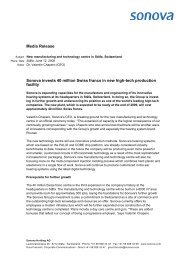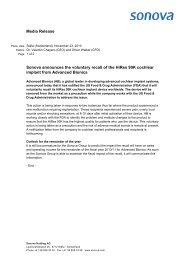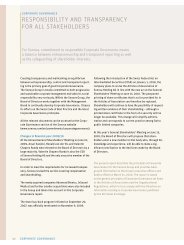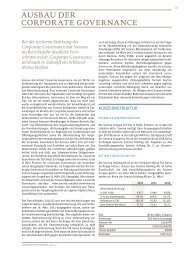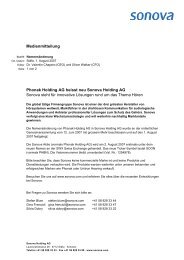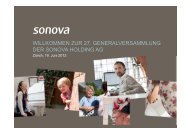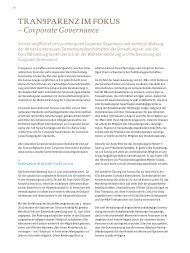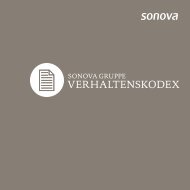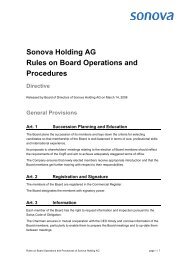You also want an ePaper? Increase the reach of your titles
YUMPU automatically turns print PDFs into web optimized ePapers that Google loves.
equity method, the investment in an associate is initially recognized<br />
at cost and the carrying amount is increased or decreased<br />
to recognize Phonak’s share of profit or loss of the acquired company<br />
after the acquisition date.<br />
The Group’s share of equity in associated companies, consolidated<br />
using the equity method, is shown in the balance<br />
sheet as “Investments in associates/joint ventures”, and its share<br />
of the results of operations for the year is shown in the income<br />
statement as “Share of (loss)/gain in associates/joint ventures”.<br />
Associates acquired during the year are accounted for as<br />
“Investments in associates/joint ventures” from the date on<br />
which significant influence over the acquired company is transferred<br />
to the Group, and derecognized from that position as<br />
of the date Phonak ceases to have significant influence over an<br />
associate.<br />
Investments in joint ventures<br />
Investments in joint ventures are accounted for using the<br />
equity method of accounting. These are contractual arrangements<br />
whereby two or more parties undertake an economic activity<br />
that is subject to joint control. Joint control is the contractually<br />
agreed sharing of control over an economic activity, and exists<br />
only when the strategic financial and operating decisions relating<br />
to the activity require the unanimous consent of the parties<br />
sharing control. Under the equity method, the investment in a<br />
joint venture is initially recognized at cost and the carrying<br />
amount is increased or decreased to recognize Phonak’s share of<br />
profit or loss of the jointly controlled entity after the acquisition<br />
date.<br />
The Group’s share of equity in joint ventures consolidated<br />
using the equity method is shown in the balance sheet as<br />
“Investments in associates/joint ventures,” and its share of the<br />
results of operations for the year is shown in the income statement<br />
as “Share of (loss)/gain in associates/joint ventures”.<br />
Joint ventures established during the year are accounted for<br />
as “Investments in associates/joint ventures” from the date on<br />
which joint control of the joint venture is transferred to the Group<br />
and derecognized from that position as of the date Phonak<br />
ceases to have joint control.<br />
3.2 Currency translation<br />
The consolidated financial statements are expressed in Swiss<br />
Francs (“CHF”), which is the company’s functional and presentation<br />
currency. The functional currency of each Group company<br />
is based on the local economic environment to which an entity<br />
is exposed, which is normally the local currency.<br />
52<br />
Consolidated Financial Statements<br />
Transactions in foreign currencies are accounted for at<br />
the rates prevailing at the dates of the transactions. The resulting<br />
exchange differences are recorded in the local income<br />
statements of the Group companies and included in net income.<br />
Monetary assets and liabilities of Group companies which<br />
are denominated in foreign currencies are translated using yearend<br />
exchange rates. Exchange differences are recorded as an<br />
income or expense. Non-monetary assets and liabilities are translated<br />
at historical exchange rates. Exchange differences arising<br />
on inter-company loans that are considered part of the net investment<br />
in a foreign entity are recorded in equity.<br />
When translating foreign currency financial statements into<br />
Swiss Francs, year-end exchange rates are applied to assets<br />
and liabilities, while average annual rates are applied to income<br />
statement accounts. Translation differences arising from this<br />
process are recorded as a separate component of equity. On disposal<br />
of a subsidiary, the related cumulative translation adjustment<br />
is transferred from equity and included in the profit or loss<br />
on disposal in the income statement.<br />
3.3 Accounting and valuation principles<br />
Cash and cash equivalents<br />
This item includes cash in hand and at banks, time deposits<br />
and other short-term highly liquid investments with original<br />
maturities of 3 months or less, as well as bank overdrafts. The<br />
cash flow statement summarizes the movements on cash and<br />
cash equivalents. Free cash flow is the net amount of the cash<br />
flow from operating and from investing activities.<br />
Trade receivables<br />
Trade receivables are recorded at original invoice amount less<br />
provision made for impairment of these receivables. A provision<br />
for impairment of trade receivables is established when there is<br />
objective evidence that the Group will not be able to collect all<br />
amounts due according to the original terms of the invoice. The<br />
amount of the provision is the difference between the carrying<br />
amount and the recoverable amount, being the present value of<br />
expected cash flows.<br />
Inventories<br />
Purchased raw materials, components and finished goods<br />
are valued at the lower of cost or net realizable value. To evaluate<br />
cost, the standard cost method is applied, which approximates<br />
historical cost determined on a first-in first-out basis. Standard<br />
costs take into account normal levels of materials, supplies,<br />
labor, efficiency and capacity utilization. Standard costs are<br />
regularly reviewed and, if necessary, revised in the light of<br />
current conditions. At each period end, any production or purchase




